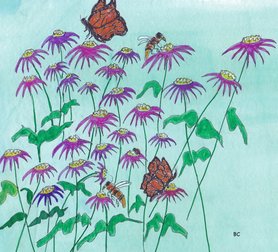This is an article was originally published in North Jersey Media's The Suburbanite
GOT MILKWEED?
BY BRENDA CUMMINGS
NORTHERN VALLEY SUBURBANITE
I was working diligently at the computer when a fruit fly nearly flew up my nose. That tiny, annoying creature flew in my face for half an hour before I finally swatted it and sent t on its way to insect Valhalla.
My insect-loving daughter told me I was a horrible person for killing the fruit fly, but even if she’s right, I don't know many people who love flies of any sort.
We tend to associate fruit flies with houseflies. Both come into our homes because they’re attracted to our food, but they’re different species. Both are beneficial because they are decomposers — but houseflies are the species responsible for the transmission of disease. The common fruit fly (dropsophila melanogaster) has contributed hugely to scientific research, helping scientists learn more about genetics, diseases and human behavior, but most of us are disgusted by flies and don’t ponder their usefulness when they’re flying in our faces.
The disgust so many of us feel toward insects is partly ingrained, and partly cultural. Many cultures eat insects, but most Americans can barely stand the thought. Even the insects that we find most disgusting have a functioning role in ecosystems. The larger human populations grow, the less room we allow for other creatures, and we tread on thin ice when we seek a quick fix to control them. We now know that habitat loss, climate disruption and the widespread use of pesticides have contributed hugely to Colony Collapse Disorder among bees, and without bees we would lose approximately 75 percent of our food crops.
We are presently in the midst of a mass extinction event. Most of us are aware of the endangered celebrity species — animals like polar bears, panda bears, tigers, elephants and rhinos. Goodness knows, the decline in their numbers is alarming, but we also need to come to the aid of the countless small animals whose numbers are declining.
According to Rodolfo Dirzo, professor of environmental science at Stanford, " … in the past 35 years … the number of invertebrate animals – such as beetles, butterflies, spiders and worms – has decreased by 45 percent." Insects are essential to pollination as well as the cycling and decomposing of organic materials. Without them, ecosystems fail. We forget that we live in and are dependent upon ecosystems. Unless we learn more about them and contribute to changing human behavior, we too will face extinction.
Recently, the monarch butterfly made headlines because the U.S. Fish and Wildlife Service has finally recognized its decline. The agency announced that the monarch may deserve protection under the Endangered Species Act. The single reason for the decline of the monarch butterfly is the loss of its food source — milkweed. Milkweed is the only plant monarch caterpillars eat and it’s where all female monarchs lay their eggs. The Fish and Wildlife Service announcement came in response to a petition from The Center for Food Safety, The Center for Biological Diversity and leading monarch scientist Lincoln Brower, professor emeritus at Sweet Briar College in Virginia. According to their research, published in June 2014, "Milkweed populations in the U.S. dropped 21 percent between 1995 and 2013. The vast majority of that milkweed loss — about 70 percent — overlapped with prime monarch breeding areas."
Milkweed has been nearly eradicated on soy and corn farms in the Midwest. This has devastated the monarch’s habitat. Logging in Mexico’s Oyamel fir forest, pesticide use, weather and climate disruption and the demise of 500 million monarchs during a winter storm in 2002 have not helped the situation.
In the meantime, planting milkweed seems to be one way we non-farmers can help. I have not had to plant milkweed seeds because I let the volunteers take over. If only a scattered few of us are planting milkweed or letting it volunteer, we won’t really have much impact. On the other hand, if thousands of people all along the monarch’s migration route planted milkweed anywhere and everywhere possible, it could very well turn the situation around.
Milkweed seeds can be acquired from several online sources, and some of them are free. Livemonarch.com asks for a self addressed, stamped envelope, and several sites sell seeds. There are many varieties of milkweed, including common milkweed, swamp milkweed and butterfly weed, which is an ornamental and has orange flowers. Many conservation societies ask for donations.
Since the FWS has not made their final decision, sending letters to Tony Sullins, Chief of Endangered Species, Midwest Region, U.S. Fish and Wildlife Service, 5600 American Boulevard West, Suite 990, Bloomington, MN, 55437 is another way we can help the monarchs.
Even the smallest, most seemingly insignificant organisms are essential to the health of ecosystems. We too are each important, and when we work together, we can make a huge difference. Plant more milkweed.
GOT MILKWEED?
BY BRENDA CUMMINGS
NORTHERN VALLEY SUBURBANITE
I was working diligently at the computer when a fruit fly nearly flew up my nose. That tiny, annoying creature flew in my face for half an hour before I finally swatted it and sent t on its way to insect Valhalla.
My insect-loving daughter told me I was a horrible person for killing the fruit fly, but even if she’s right, I don't know many people who love flies of any sort.
We tend to associate fruit flies with houseflies. Both come into our homes because they’re attracted to our food, but they’re different species. Both are beneficial because they are decomposers — but houseflies are the species responsible for the transmission of disease. The common fruit fly (dropsophila melanogaster) has contributed hugely to scientific research, helping scientists learn more about genetics, diseases and human behavior, but most of us are disgusted by flies and don’t ponder their usefulness when they’re flying in our faces.
The disgust so many of us feel toward insects is partly ingrained, and partly cultural. Many cultures eat insects, but most Americans can barely stand the thought. Even the insects that we find most disgusting have a functioning role in ecosystems. The larger human populations grow, the less room we allow for other creatures, and we tread on thin ice when we seek a quick fix to control them. We now know that habitat loss, climate disruption and the widespread use of pesticides have contributed hugely to Colony Collapse Disorder among bees, and without bees we would lose approximately 75 percent of our food crops.
We are presently in the midst of a mass extinction event. Most of us are aware of the endangered celebrity species — animals like polar bears, panda bears, tigers, elephants and rhinos. Goodness knows, the decline in their numbers is alarming, but we also need to come to the aid of the countless small animals whose numbers are declining.
According to Rodolfo Dirzo, professor of environmental science at Stanford, " … in the past 35 years … the number of invertebrate animals – such as beetles, butterflies, spiders and worms – has decreased by 45 percent." Insects are essential to pollination as well as the cycling and decomposing of organic materials. Without them, ecosystems fail. We forget that we live in and are dependent upon ecosystems. Unless we learn more about them and contribute to changing human behavior, we too will face extinction.
Recently, the monarch butterfly made headlines because the U.S. Fish and Wildlife Service has finally recognized its decline. The agency announced that the monarch may deserve protection under the Endangered Species Act. The single reason for the decline of the monarch butterfly is the loss of its food source — milkweed. Milkweed is the only plant monarch caterpillars eat and it’s where all female monarchs lay their eggs. The Fish and Wildlife Service announcement came in response to a petition from The Center for Food Safety, The Center for Biological Diversity and leading monarch scientist Lincoln Brower, professor emeritus at Sweet Briar College in Virginia. According to their research, published in June 2014, "Milkweed populations in the U.S. dropped 21 percent between 1995 and 2013. The vast majority of that milkweed loss — about 70 percent — overlapped with prime monarch breeding areas."
Milkweed has been nearly eradicated on soy and corn farms in the Midwest. This has devastated the monarch’s habitat. Logging in Mexico’s Oyamel fir forest, pesticide use, weather and climate disruption and the demise of 500 million monarchs during a winter storm in 2002 have not helped the situation.
In the meantime, planting milkweed seems to be one way we non-farmers can help. I have not had to plant milkweed seeds because I let the volunteers take over. If only a scattered few of us are planting milkweed or letting it volunteer, we won’t really have much impact. On the other hand, if thousands of people all along the monarch’s migration route planted milkweed anywhere and everywhere possible, it could very well turn the situation around.
Milkweed seeds can be acquired from several online sources, and some of them are free. Livemonarch.com asks for a self addressed, stamped envelope, and several sites sell seeds. There are many varieties of milkweed, including common milkweed, swamp milkweed and butterfly weed, which is an ornamental and has orange flowers. Many conservation societies ask for donations.
Since the FWS has not made their final decision, sending letters to Tony Sullins, Chief of Endangered Species, Midwest Region, U.S. Fish and Wildlife Service, 5600 American Boulevard West, Suite 990, Bloomington, MN, 55437 is another way we can help the monarchs.
Even the smallest, most seemingly insignificant organisms are essential to the health of ecosystems. We too are each important, and when we work together, we can make a huge difference. Plant more milkweed.


 RSS Feed
RSS Feed
